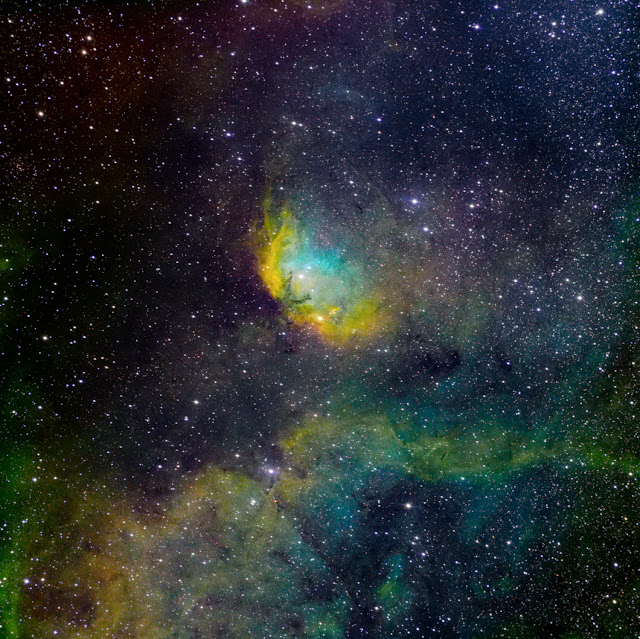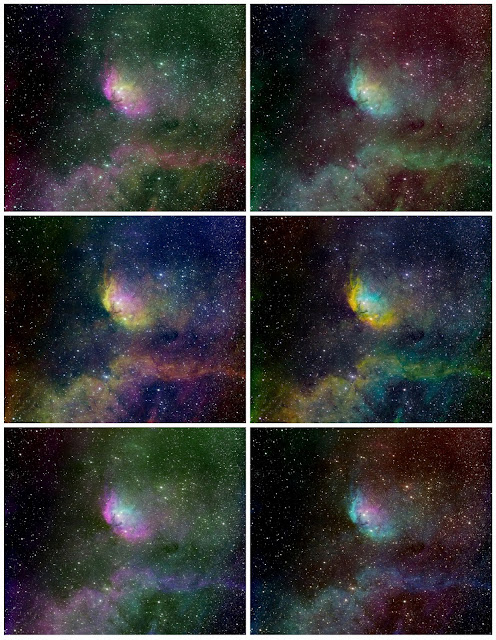Two and a half hours of data: H-alpha (1 hour), OIII (40 min) and SII (50 min) on the Tulip nebula captured with AstroDMx Capture through a William Optics 81mm APO refractor fitted with a ZWO EAF focuser, an 0.8 reducer/flattener, an Altair magnetic filter holder v2, a manual camera rotator and an SV605MC cooled monochrome, 14 bit CMOS camera. The equipment was mounted on a Celestron AVX mount. An SVBONY SV165 guide scope with a QHY-5II-M guide camera was used for guiding.
Clicking on an image will give a closer view
The equipment imaging near the zenith
We have adopted a more rigorous cable management system for our testting which can be seen quite well here. Apart from the usual reasons for managig the cables, such as reducing the likelyhood of snagging, neatness and greater ease in putting up and taking down the cables; a major benefit is that there is absolutely no cable weight pulling down from the camera end of the setup. The signal cables are routed via cable management clips on the tube rings to within a cable management tube, and the camera power cable is routed via cable management clips on the tube rings and attached to the outside of the cable managemen tube. However, the cable management tube is suspended from a cable management clip on the mount iteself which takes all of the weight of the cables. The greatest benefit of this is that we experience even better alignment, tracking and guiding. We have adopted this system for all of our test rigs. In some cases the cable management clips are attached to the OTA itself if tube rings are not used.
As usual, the mount was placed on marks on the ground which quickly gives quite a good polar alignment if care is taken with the placement of the tripod feet.
Mount and focus control were done by AstroDMx Capture via an INDI server running on the imaging computer indoors.
Auto pulse-guiding was done by a separate Linux computer also running indoors (although it could have been done if required, on the imaging computer). The way we do it facilitates the involvement by two people. Although it would be possible to just leave the equipment to get on with the imaging, we prefer to be involved with both the imaging and the auto-guiding in real time.
AstroDMx Capture sent the mount with plate solving, to the star Altair for focusing with a Bahtinov mask.
PHD2 auto pulse guiding was set up and calibrated, and then optimised with Guiding assistant.
The Tulip nebula, SH2-101 has an HD star, HD 189777, conveniently placed within it. Once guiding had been established and guiding assistance performed, guiding was switched off and AstroDMx Capture sent the scope/mount to HD 189777 with repeated plate solves until an accuracy of 5 arc seconds was achieved. Then guiding was switched on again. This placed the Tulip nebula in the middle of the camera’s field of view.
AstroDMx Capture captured 1 hour’s worth of 5 minute exposures of the Tulip nebula and surrounding nebulosity using a H-alpha filter.
Using a negative preview
A meridian flip was performed with repeated plate solving until an accuracy of 5 arcseconds was achieved in the centering of HD 189777.
Then 40 minutes worth of 5 minute exposures were captured using an OIII filter and 50 minutes worth of 5 minute exposures using an SII filter. The number of frames captured was determined by available time and occasional cloud ingress.
Matching Dark frames, Flat fields, Dark Flats and Bias frames were also captured.
The three data sets were calibrated and stacked in Deep Sky Stacker using the best frame from the H-alpha images as the reference frame. This way, all three channels were perfectly co-aligned.
The images were processed in the Gimp 2.10, Starnet++ Gimp plugin, Neat image and Photoscape X Pro.
The Tulip nebula in the SHO Hubble palette
The Tulip nebula was rendered in all 6 of the possible palettes which are presented in the montage below. The Palettes are arranged in the montage according to the following table where H-alpha, OIII and SII are assigned to the RGB colour channels as shown. e.g. SHO means: S assigned to R; H assigned to G; and O assigned to B etc.
Palette Montage
There have been some slight delays in the development of AstroDMx Capture as we have been building a much more powerful Ryzen 9 zen-4 computer for software development. Development is now back on track, and with some improvements to exposure control, and SDK updates, the next release shouldn’t be too long.
Nicola has laid the groundwork for the implementation of the INDIGO framework, which will be the next major advance in this multi platform capture and control software.







